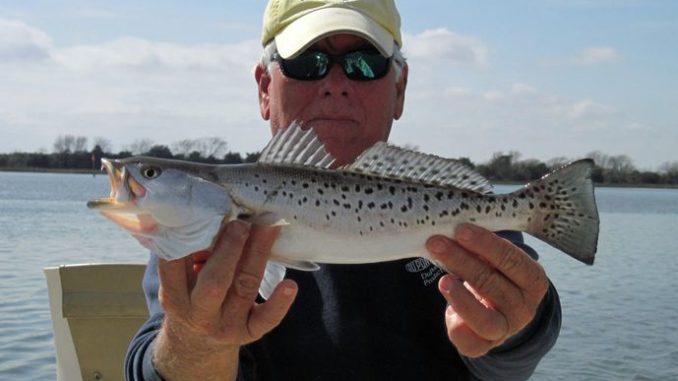
Guide expecting banner year because bite has started so early
Artificial lures are the ticket to quality speckled trout in the Hilton Head area right now, and it doesn’t seem to matter too much which artificial lure anglers are throwing. The bite is so good at this early stage in the fall, that many seasoned anglers are looking for it to be a banner year, including Capt. Rick Percy of Reel Chance Charters.
The tide cycle doesn’t seem to matter too much, either, as long as it is moving in one direction or the other. Percy said he has had the most luck in the past few days on the falling tide, but he said that can change any day, with the better tide being the incoming.
Norton lures, Vudu shrimp, and MirrOLure Lil John soft plastics are all good choices, and Percy has had success using all of them either with or without a popping cork. He said the main thing for anglers to keep in mind is that trout like clean water, so he suggests bypassing stained or muddy water and focusing on the clearest water they can find.
Percy (803-535-6166) said one mistake many fishermen make is anchoring improperly. He said anglers shouldn’t get hung up on anchoring and casting in only one direction. He often anchors up in an area really close to the bank, then casts away from the bank rather than toward it. The trick, he said, is to pitch your lures where the current breaks the strongest, or where two opposing currents meet.
“Especially when using a popping cork, anglers should cast into the current, but not directly where the strongest current break is. They should let the current carry it there,” Percy said. “Give it a twitch here and there to get the cork popping, and pay close attention as it nears the break or the spot where two currents collide.”
These spots are easy to locate at low tide and usually consist of a large shell bed or sandbar that protrudes perpendicular to a bank. When the tide comes in, each side of the shell bed or sandbar has an influx of water that eventually collides with it. And just off the point of that break, the water collides and swirls until one current overtakes the other. Trout love to hang out in these areas to ambush prey, so they are looking to bite when a lure floats by.
Percy likes using spinning reels in the 2000-3000 class with 7-foot, medium-action rods with fast tips. He likes 20-pound braided line, and when using a popping cork, he prefers a 12- to 15-inch monofilament leader coming off the cork. When not using a cork, Percy uses the same leader and attaches the braid to leader with a surgeon’s knot, then ties on the lure with a MirrOLure knot.
Percy said he expects the trout bite to get even hotter as the water continues to cool and doesn’t expect the fishing to slow down anytime soon.





Be the first to comment